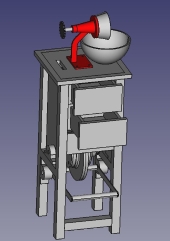
 2
2




De-fund the Mosquito Police!
Become extra-civilized...
 3
3




"Study books and observe nature; if they do not agree, throw away the books." ~ William A. Albrecht
 8
8





 1
1








John Daley Bendigo, Australia The Enemy of progress is the hope of a perfect plan
Benefits of rainfall collection https://permies.com/t/88043/benefits-rainfall-collection
GOOD DEBT/ BAD DEBT https://permies.com/t/179218/mortgages-good-debt-bad-debt
 2
2




John Daley Bendigo, Australia The Enemy of progress is the hope of a perfect plan
Benefits of rainfall collection https://permies.com/t/88043/benefits-rainfall-collection
GOOD DEBT/ BAD DEBT https://permies.com/t/179218/mortgages-good-debt-bad-debt
 3
3




 1
1




Visit Redhawk's soil series: https://permies.com/wiki/redhawk-soil
How permies.com works: https://permies.com/wiki/34193/permies-works-links-threads








 1
1




Jay Angler wrote:@ L Johnson: Have you had a look at the traditional Japanese house joinery? It's designed to wiggle in earthquakes without failing (up to a point). I'm not sure it's still practiced, as I suspect that sort of apprenticing took years and "modern" is faster and cheaper, even if it's not better.
That said, Japanese homes were generally smaller than what many people want to build in North American, so the concern with "can this scale up" still applies.
 3
3




 2
2




Trees are our friends
 1
1




Daniel Schmidt wrote:It's virtually impossible to suggest a good course of action without a lot more details for what you have planned.
De-fund the Mosquito Police!
Become extra-civilized...
 2
2




Andrew Pritchard wrote:For my money, I'd prefer to learn how to do proper mortise and tenon joinery. Metal fastenings tend to losen over time especially for something like a workbench which tends to have quite a bit of abuse, but good M&T are incredibly strong. Especially if you learn how to do Drawboring. People have been building buildings with M&T which have lasted literally centuries - my Aunt's house in England was built in the 16th century and uses drawboring M&Ts.
A mortise is a slot or hole in one piece, and a tenon fits snuggly inside that hole. Typically this is at 90degrees, but you can do knee bracing at 45 etc. Drawboring is a technique whereby you drill a hole through the sides of the mortise, and a slightly off centre hole through the tenon towards the shoulder of the tenon. Driving a peg through the holes, sucks the tenon into the mortise creating an incredibly strong joint.
https://www.youtube.com/results?search_query=draw+boring
De-fund the Mosquito Police!
Become extra-civilized...




Visit Redhawk's soil series: https://permies.com/wiki/redhawk-soil
How permies.com works: https://permies.com/wiki/34193/permies-works-links-threads
 1
1




De-fund the Mosquito Police!
Become extra-civilized...




De-fund the Mosquito Police!
Become extra-civilized...
 3
3




Coydon Wallham wrote:You brought up another important point about pocket screws that I had forgotten to ask about- torquing them in.
Also, when you use deck screws for pocket holes, are you using a jig to drill the holes? For larger dimensions are you using a regular bit, then following up with the long bit you mention?
Trees are our friends
 1
1








Daniel Schmidt wrote:I have built temporary scaffolds in a similar fashion, and I can tell by looking at it that below the point of the bracing, those 2x4's will flex and will get a bit bouncy when doing certain actions standing on top. All of your legs have the 2x4's in the same orientation (1.5" sides all facing the same way, as are the 3.5" sides). If you take more 2x4's and make them into an L shape, that is, leaving the existing 3.5" side as-is and putting the 3.5" side of new boards to the 1.5" side (making an L shape 5" in one direction and 3.5" in the other) it will be more sturdy than just doubling up the 2x4's into a 3" x 3.5" block. You will have much less flexing below the line where the braces attach. Adding another set of diagonal bracing to the other two sides supporting the joists will further increase rigidity and make it feel quite solid.
De-fund the Mosquito Police!
Become extra-civilized...
 2
2




Trees are our friends




Andrew Pritchard wrote:For some reference, Matthias Wandel who is a prolific woodworker with pragmatic approach, did a test comparing the strength pocket holes vs mortise and tenon:
https://www.youtube.com/watch?v=apsH8eBfjVA
De-fund the Mosquito Police!
Become extra-civilized...








 2
2




Coydon Wallham wrote:
Also, are there ways to form the mortise and tenon that they hold without glue?
 2
2




Coydon Wallham wrote: Also, are there ways to form the mortise and tenon that they hold without glue?
Trees are our friends





|
First, you drop a couch from the plane, THEN you surf it. Here, take this tiny ad with you:
The new kickstarter is now live!
https://www.kickstarter.com/projects/paulwheaton/garden-cards
|









